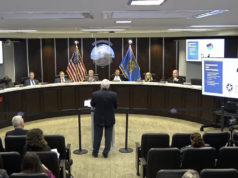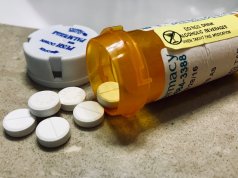
Quick! Which drug is responsible for the most unintentional overdoses in Oklahoma?
I’ll give you five seconds. Five … four … three … two … one.
Time’s up. Did you say meth? You’re wrong. Cocaine? Wrong. Heroin? Wrong again, but you’re getting warmer.
The most deadly drug in Oklahoma doesn’t come from a shady street dealer, and it isn’t grown in far away poppy fields or steamy jungles. Instead, it’s developed by chemists in labs and distributed by your family practitioner.
Oxycodone, most widely distributed under the brand name OxyContin, from Purdue Pharma, has been responsible for 791 deaths in Oklahoma between 2007 and 2012, according to state data. Compare that to 594 for alcohol, 463 for meth, 289 for cocaine and only 80 for heroin during the same period.
| Drug | 2007 | 2008 | 2009 | 2010 | 2011 | 2012 | Total |
| Hydrocodone | 118 | 116 | 133 | 141 | 127 | 152 | 787 |
| Oxycodone | 115 | 121 | 129 | 135 | 130 | 161 | 791 |
| Alprazolam | 131 | 114 | 134 | 133 | 109 | 112 | 733 |
| Methadone | 171 | 117 | 100 | 91 | 69 | 80 | 628 |
| Morphine | 60 | 80 | 75 | 72 | 94 | 82 | 463 |
| Fentanyl | 44 | 56 | 77 | 51 | 48 | 57 | 333 |
| Diazepam | 24 | 32 | 41 | 40 | 44 | 31 | 212 |
| Carisoprodol | 13 | 46 | 34 | 35 | 38 | 32 | 198 |
| Tramadol | 11 | 24 | 22 | 23 | 30 | 40 | 150 |
| Citalopram | 12 | 20 | 22 | 27 | 22 | 13 | 116 |
| Alcohol | 77 | 98 | 104 | 110 | 115 | 90 | 594 |
| Methamphetamine | 39 | 37 | 68 | 96 | 101 | 122 | 463 |
| Cocaine | 67 | 46 | 39 | 45 | 48 | 44 | 289 |
| Heroin | <5 | 11 | 18 | 6 | 16 | 29 | 80 |
Poppin’ pills in the Sooner State
In Oklahoma, the rising death toll of prescription drugs over traditional street drugs is clear. To say Oklahoma has a meth problem is still famously true, but the much greater (and oft-ignored) truth is that Oklahoma has a prescription pill problem. Altogether, the four prescription pills outlined above have been responsible for more than double the number of deaths resulting from alcohol poisoning, meth, coke and heroin overdoses combined during the period.
The problem is inherently related to the large number of pain-pill prescriptions written by medical providers in Oklahoma. The numbers are staggering. According to this NewsOK story from August:
…in 2012, Oklahoma health care providers wrote 128 painkiller prescriptions for every 100 Oklahomans. Nationally, the statistic is 82 painkiller prescriptions for every 100 people.
A national epidemic
Meanwhile, heroin-related deaths in America have quadrupled since 2002. In this CNN article from July, the director of the Centers for Disease Control, Dr. Thomas Frieden, offered his primary reason why such overdoses have become so common: “More and more people are susceptible to heroin because they have been prescribed prescription opiates, like OxyContin.”
Nationwide, prescription pills accounted for 44 percent of all overdose deaths in 2010. Following a $635 million fine stemming from false marketing charges, Purdue Pharma began reformulating its more heavily abused pills with features that thwart potential abusers.
Clear solutions remain elusive
In 2013, the FDA issued guidelines for labeling and evaluating abuse-deterrent opioids, but some argue that changing the properties of the pills themselves treats merely a symptom of the prescription overdose epidemic while ignoring the cause. For such critics, lack of oversight for doctors and pharmaceutical manufacturers remains the crux of America’s addiction to pain pills.
In Oklahoma, measures have been implemented to address such criticism. With regard to oversight, Oklahoma implemented a prescription monitoring program (PMP) in 2006, which requires “every pharmacy or dispensing practitioner” to report details about the pills they prescribe and to whom. In January 2012, the Bureau of Justice Assistance lauded Oklahoma’s PMP for being the first in the nation to provide real-time access to prescription data. On Nov. 1 of this year, providers became required to check the PMP before prescribing painkillers to new patients.
Still, the state’s PMP exempts “licensed hospital pharmacies; licensed nurse or medication aide who administers a controlled substance at the direction of a licensed physician” from reporting.
Critics of these measures claim further stigmatization of drug abusers and addicts as criminals instead of people with substance abuse issues stemming from either mental health ailments or chronic pain.
“The tide has shifted from demonizing pain medication to demonizing people with pain,” said psychosocial specialist Yvette Colón in this 2012 article from Social Work Today magazine.
Media have tended to exacerbate this perception during the interim, as research finds: “U.S. news coverage has primarily framed the opioid drug abuse epidemic as a criminal justice issue rather than a public health problem.”
Last, the National Sheriff’s Association has supported the enabling and training of first responders to use “rescue drugs” such as naloxone, which can be administered to reverse the effects of opioid overdose. On Dec. 7, the NSA launched a nationwide pilot training program on the back of a $350,000 grant from, of all sources, Purdue Pharma.
Some progress
According to an article from October, “The number of Oklahomans dying from unintentional prescription drug overdoses has dropped to its lowest level in eight years.”
That progress, combined with prior levels of rampant opioid abuse, provided impetus for the Oklahoma Association for the Treatment of Opioid Dependence to host the state’s first conference addressing the opioid epidemic.
Further, a “Good Samaritan” law will be proposed during the Oklahoma Legislature’s upcoming session, which would potentially protect people who call 9-1-1 in the event of an overdose from facing drug charges.
Still, the data must be watched and news events analyzed during the coming year to ensure the progress made continues. As mentioned above, media have largely failed to present a holistic picture of opioid abuse in this country, relying instead on a traditional narrative of drugs bad, cops good. The ignorance persists: As of 5 p.m., a search of CriticalMention.com showed zero media outlets had made any mention the opioid abuse conference as it occurred Wednesday in Norman.
Perhaps it was overshadowed by Obama’s drug czar, Michael Botticelli, hosting the first of several community forums on opioid abuse at the Indian Health Care Resource Center in Tulsa the same day.
Botticelli appear on 60 Minutes this past Sunday.




















